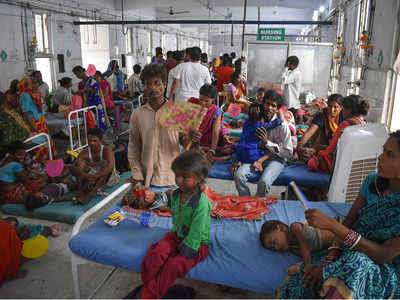- News
- India News
- Encephalitis spreads to other districts of Bihar, toll at 114
Encephalitis spreads to other districts of Bihar, toll at 114

- The toll in the outbreak of acute encephalitis syndrome in Bihar rose to 114 with seven more deaths in the endemic zone
- Reports also came in of children being admitted with similar symptoms in other districts like Samastipur, Banka and Vaishali
- Around 40 to 50 new cases of AES have been coming every day, but our resources are very limited, said a government hospital superintendent
Sri Krishna Medical College and Hospital (SKMCH) in Muzaffarpur, where most of the patients have been undergoing treatment since the disease spread, struggled to handle the spate of new admissions with its limited infrastructure.Sources at the hospital said the stream of high-profile visitors, including the chief minister and the Union health minister, was adding to the chaos.
The scarcity of beds and doctors continued even as the Bihar State Health Society issued a list of 15 doctors, technicians and nurses deputed by the Union health ministry to assist at the hospital. "All 637 beds, including 30 in the paediatric ICUs, are occupied. We have had to put two kids on one bed to accommodate more children," SKMCH superintendent Sunil Kumar Shahi said.
He admitted that there was a shortage of senior resident doctors in every department. "Though there is a shortage, it is inhuman to turn away patients just because we cannot accommodate them. Many of them have come from far-flung villages of north Bihar. Around 40 to 50 new cases of AES have been coming every day, but our resources are very limited."
In Vaishali, civil surgeon ID Ranjan said 15 suspected cases of AES had been reported from Hajipur. "Several kids have died in the villages there. Some have died in the referral hospital before being diagnosed. Their relatives say they had high fever and convulsions, among other symptoms indicative of AES."
At least three of seven infants with AES symptoms admitted to the Sadar hospital in Samastipur were referred to the SKMCH. One of them died on the way. But civil surgeon Siyaram Mishra denied that any AES patient had been admitted at the Sadar hospital.
In Banka district, the death of a two-year-old in a village in Katoria block has caused alarm.
Muzaffarpur DM Alok Ranjan Ghosh has cancelled the leave of all government employees in the district. "The number of children admitted with AES symptoms since June 1 has gone up to 5,530. Till Wednesday, 187 kids were discharged after treatment while 101 of them are still under the care of the two main medical institutions in the district. The condition of 24 children is critical. All of them are on ventilators," Ghosh said. "A massive awareness campaign has started in all blocks with the help of Jiveeka associates and aanganwadi sevikas and sahayeekas. Executive magistrates have been deployed in every block to monitor the awareness programme, apart from keeping a close vigil on the patients with AES."
Neighbouring Ranchi is also in the grip of an AES scare, with anxious parents taking their children to hospitals at the slightest hint of any symptom associated with the disease.
Nisha Devi, a mother of two daughters aged six and four, said: "Both my daughters have been running a fever for two days. Though the paediatrician I visited advised rest and prescribed a few medicines, I insisted on complete blood tests for both to rule out AES."
Standing in a line with his four-year-old daughter at Ranchi Sadar Hospital, Jagatram, a worker in an electronics shop, looked and sounded worried. "I brought her here because she was running a temperature all night. With so many kids dying in Bihar, I cannot take any risk," said the father of two.
District civil surgeon BV Prasad told TOI that the Ranchi administration would release guidelines for AES awareness to quell the panic and confusion.
"It is a good thing that parents are alert. Although this means long queues in the paediatric departments, chances of a case going undetected are minimised. We will be releasing a communique informing people about AES and its symptoms. Fever, vomiting and convulsions - all three symptoms are generally connected with AES and parents of small kids experiencing even one of those should consult a doctor," he said.
Little children dying or suffering permanent brain damage is always a human tragedy, but when official apathy and neglect contirbute to it, that is criminal dereliction of duty. Bihar has seen these deaths happen year after year even if the numbers have in one year gone down and in another shoot up. Muzaffarpur has been the epicenter. Given those facts, it is just inexcusable that the government has failed so miserably in ensuring the public health set-up is equipped to cope. Grand schemes count for little if they are of no help to poor families losing their little ones. Of course, tackling this disease needs more than just good PHCs or hospitals. As long as malnutrition is rampant, the problem will remain. To root it out, therefore, adequate nutrition is the first step. But that does not preclude effective medical intervention to ensure that the loss of lives is kept to the minimum if not eliminated altogether.
(With inputs from Debjani Chakraborty in Ranchi)










